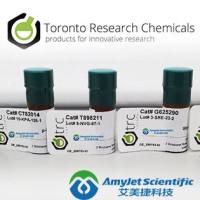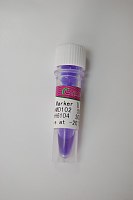Plant DNA methylation analysis by bisulfite genomic sequencing
互联网
Introduction
The following "bisulfite genomic sequencing" protocol has been optimized for the determination of DNA cytosine methylation at transgene loci in plants. The conditions used are based on the method given by Pelissier and Wassenegger (2000).
Back to top
Procedure
Preparation of Plant Genomic DNA
Prepare plant genomic DNA using a Qiagen DNeasy Plant Maxi or Mini kit (see comment 1).
Prior to the bisulfite-treatment, the plant genomic DNA is cleaved at sites outside of region intended for amplification to resolve structures like direct or inverted repeats that could interfere with PCR (see comment 2).
To a 1.5ml reaction tube,
- Add genomic DNA dissolved in bidist. water (e.g. 2.5µg for Arabidopsis or 25µg for tobacco depending on the genome size of the respective plant species; less DNA (>0.5µg) may be used without "downscaling" the protocol, but downstream PCR might then require more cycles and/or a larger volume of bisulfite-treated target DNA solution);
- Fill up with bidist. water to a final volume of 270µl;
- Add 30µl 10X reaction buffer (appropriate for restriction enzyme);
- Add restriction enzyme, ~10U/µg of genomic DNA;
- Incubate over night (~14 hours) at temperature appropriate for used restriction enzyme;
- Add 0.5ml Tris-buffer-saturated phenol-chroroform, vortex;
- Centrifuge with Eppendorf 5414 or equivalent at 10000 x g for 2 minutes;
- Transfer the upper aqueous phase to clean 1.5ml reaction tube;
- Add 0.5ml chloroform, vortex;
- Centrifuge as in step 7;
- Transfer the upper aqueous phase to clean 1.5ml reaction tube;
- Add 35µl 3M NaOAc/HOAc pH 5.0; 850µl abs. ethanol;
- Incubate >1 hour at -20°C (see comment 3);
- Centrifuge Sigma 1-15K (or equivalent) >15 minutes at 4°C 12000rpm (12000 X g);
- Discard supernatant, add 1.0ml 70% ethanol (room temperature), vortex;
- Centrifuge Sigma 1-15K (or equivalent) >15 minutes at 4°C 12000rpm (12000 X g);
- Discard supernatant, vacuum dry for 10 minutes at room temperature;
- Dissolve cut DNA in 10µl bidist water (0.25 or 2.5 µg/µl, respectively), store at -20°C;
Bisulfite treatment
The bisulfite solution should always be made fresh the same day as it will be used. One should get started early to make it, as it will usually take some hours for the sodium bisulfite and urea to dissolve completely. It is essential to adjust the pH of the solution to the required 5.0 at room temperature. Otherwise, incomplete conversion of unmethylated cytosines could be the result. 10M NaOH should always be prepared freshly as well.
The genomic DNA is first denatured by alkaline treatment and then incubated with bisulfite in the presence of urea. To support complete conversion, repeated heat denaturation steps are performed during the incubation. After the reaction, the DNA is cleaned up and desulfonated for PCR amplification.
First day:
- To a 0.5ml thin walled PCR reaction tube (Eppendorf 0030 124.502); add 4.0µl (1µg) restriction-cut genomic DNA (see above), add 6.0µl bidist. water, add 0.35µl 10M NaOH;
- Incubate 20 minutes at room temperature;
- Add 68µl bisulfite solution freshly made as indicated above;
- Overlay 3 drops (~100µl) mineral oil;
- Incubate in a PCR cycler over night: 2 minutes at 95°C 1 time, 2 hours at 75°C followed by 1 minute at 95°C 9 times, hold at 75°C. Some precipitate will form, but this will not interfere with later steps; proceed to the DNA cleanup immediately after completion of the bisulfite reaction.
Second day:
- Transfer the reaction solution (including the oil, but without the precipitate) to a 1.5ml reaction tube;
- Add 1.0ml Wizard DNA clean up resin (Promega kit #A7280), vortex (see comment 4);
- Load resin on provided column, apply vacuum (vacuum flask, membrane pump);
- Add 2.0ml 80% (v/v) 2-propanol on column, apply vacuum (vacuum flask, membrane pump);
- Transfer column with resin to 1.5ml reaction tube, add 50µl bidist. water preheated to 64°C for DNA elution;
- Incubate 1 minute at room temperature;
- Centrifuge Eppendorf 5414 2 minutes;
- To DNA solution (~50µl), add 40µl bidist. water, add 3.0µl 10M NaOH (prepared the day before);
- Incubate 20 minutes 37°C (incubator);
- Add 200µl 4.5M ammoniumacetate (Sigma A-1542, 17.34g dissolved in bidist. water to a final volume of 50ml) (see comment 5);
- Add 750µl absolute ethanol (see comment 6);
- Incubate >1 hour at -20°C;
- Centrifuge Sigma 1-15K (or equivalent) >15 minutes at 4°C 12000rpm (12000 X g);
- Discard supernatant, add 1.0ml 70% ethanol (room temperature), vortex;
- Centrifuge Sigma 1-15K (or equivalent) >15 minutes at 4°C 12000rpm (12000 X g);
- Discard supernatant, vacuumdry for 10 minutes at room temperatur;
- Dissolve DNA in 50µl bidist. water (20ng/µl or 200ng/µl, respectively), store at -20°C;
PCR
See comment 7. The upper limit for the length of PCR products to be amplified from bisulfite-treated DNA should be in the range of some 400 to 500 nucleotides. Primers for PCR amplification are designed to contain degenerate nucleotides (G/A for the 1st primer, C/T for the second primer) to allow for alternative C or "T" (actually dU) nucleotides in the bisulfite-treated template DNA. Primer length should be approximately 21 to 24 nucleotides; the Tm should be in the range of 50-60°C. Preferably, primers should not contain more than 3 degenerate bases, but more (up to 5?) can be tolerated for one of the two primers. In this case, it can be favourable to replace the G/A (R) or C/T (Y) degenerate nucleotides by inosine (I), which is able to basepair with any of the nucleotides present in DNA. Some examples for primer pairs that were used successfully (Aufsatz et al . 2002, Kanno et al . 2004) are:
|
NOSpro-NPTII top strand (optimal Tamp for PCR: 55.0°C |
|
|---|---|
| NOSpro-top-2 | 5' YAT GAG YGG AGA ATT AAG GGA GT 3' |
| nptII-top-2 | 5' CCR AAT ARC CTC TCC ACC CAA 3' |
| NOSpro-NPTII bottom strand (optimal Tamp for PCR: 50.0°C): | |
|---|---|
| NOSpro-bot-2 | 5' CAC RTT ATR ACC CCC RCC 3' |
| nptII-bot-3 | 5' AGI AGI IGA TTG TIT GTT GTG 3' |
| alpha'pro-GFP top strand (optimal Tamp for PCR: 52.3°C): | |
|---|---|
| T2f | 5' AYG YGA TAG AAA AYA AAA TAT AG 3' |
| T1r | 5' CCT TTA CTC ATT RTT ATA TCT CC 3' |
Primers were ordered from Metabion "OPC-purified" as stock solutions of 100pmol/µl.
[1] [2] [3] 下一页







